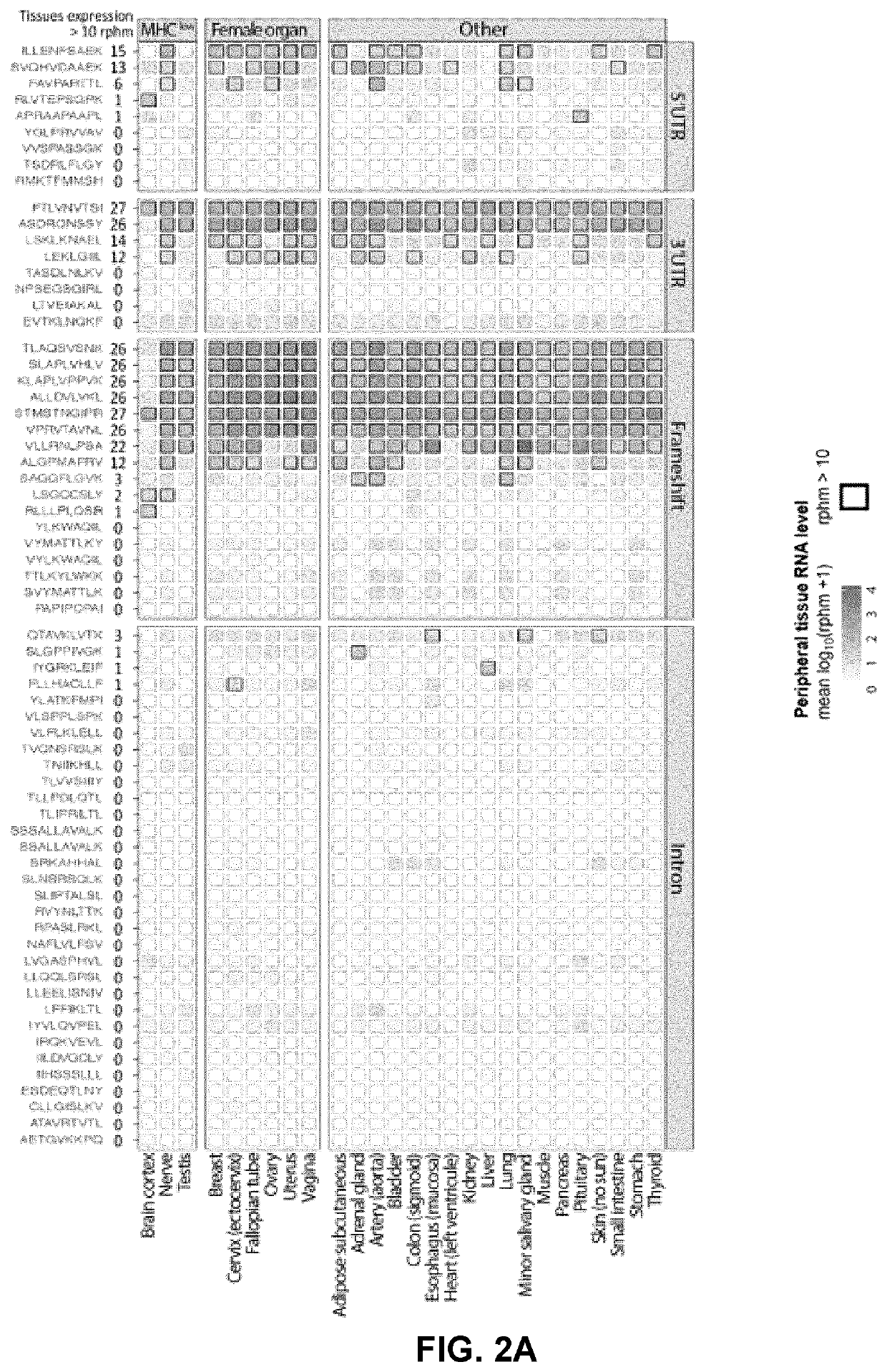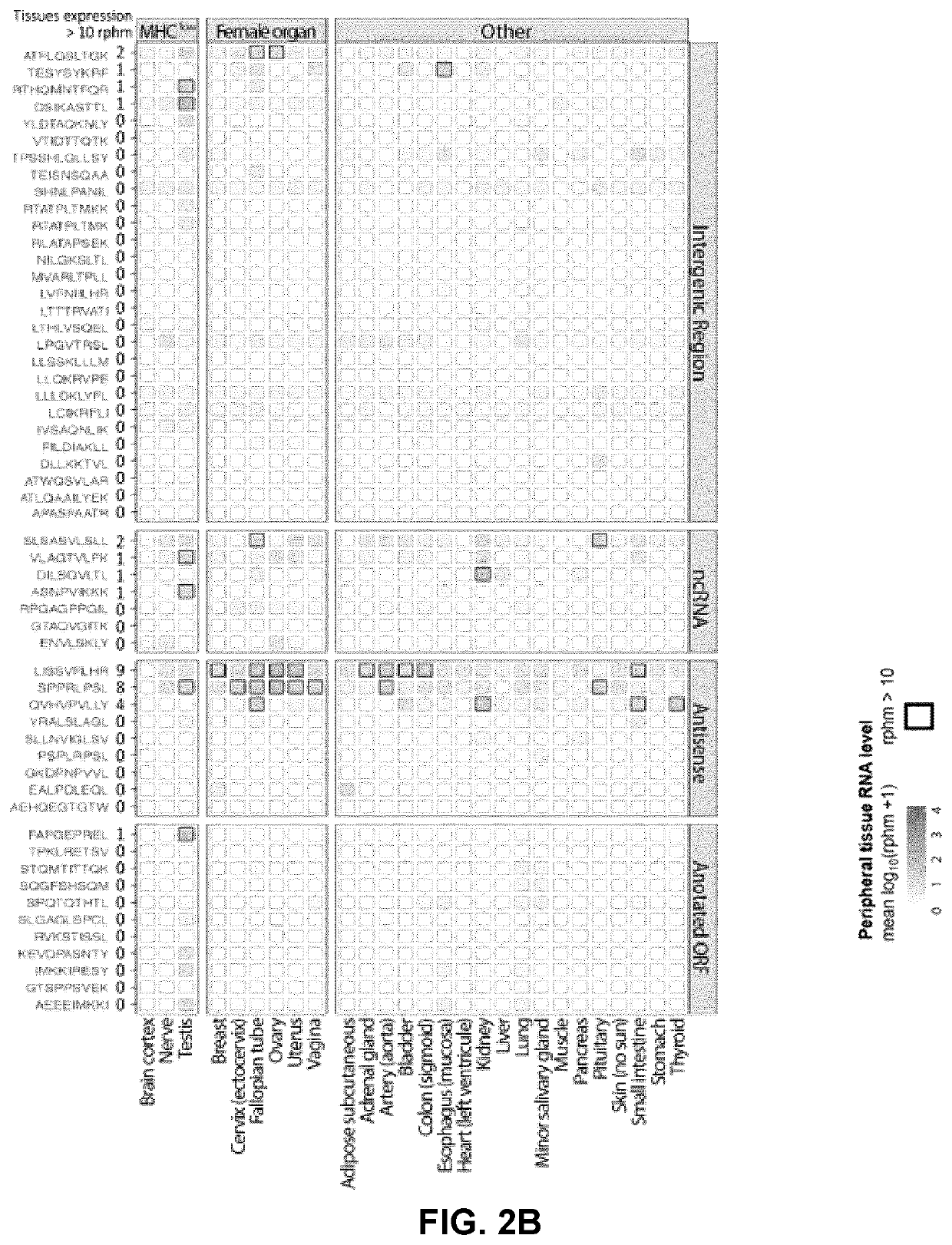Novel tumor-specific antigens for ovarian cancer and uses thereof
- Summary
- Abstract
- Description
- Claims
- Application Information
AI Technical Summary
Benefits of technology
Problems solved by technology
Method used
Image
Examples
Example
Example 1: Materials and Methods
[0093]Human HGSC samples. Tumor fragments of HGSC 1˜6 and matched normal adjacent tissues of HGSC 1˜3 were obtained from Tissue Solutions (Glasgow, GB). Tumortissue (OV606) or ascites (OV633 and OV642) were obtained from the Princess Margaret Cancer Registry (Toronto, ON, Canada). Snap frozen samples were used for RNA extraction and MHCI-associated peptide isolation. RNA sequencing data for OvCa48˜114 were downloaded from the National Center for Biotechnology Information Sequence Read Archive under project PRJNA398141, converted to fastq file, and processed like the other samples. MS raw data of the samples in this cohort were downloaded from ProteomeXchange Consortium via the PRIDE partner with identifier PXD007635. HLA typing of each sample was obtained from RNA sequencing (RNA-Seq) data using OptiType™ v1.0 with default parameters (24). Sample information is presented in Table 1.
TABLE 1RNA SampleSample integrityMAPs nametypeHLA allelesnumberidentif...
Example
Example 2: Proteogenomic Analyses Identify 111 TSAs in 23 HGSCs
[0108]To get a systems-level characterization of the TSA landscape, direct MAP identification with high-throughput tandem MS (MS / MS) analyses (34-36) was performed. Current search engines rely on user-defined protein databases to match each acquired MS / MS spectrum to a peptide sequence (37). Hence, a peptide in a test sample can only be identified by the search engine when its sequence is included in the reference database. Since generic reference protein databases such as UniProt do not contain sample-specific mutations, out-of-frame translation events and non-exonic sequences, the quest to capture TSAs coded by all genomic regions required construction of customized databases containing tumor-specific translation products for each tumor. Therefore, the recently described proteogenomic approach (15) was used to build a customized search database from RNA-Seq reads of each sample analyzed. Such customized databases conta...
Example
Example 3: Most HGSC TSAs are Unmutated MAPs Resulting from Non-Canonical Translation
[0112]With an average of 2200 unique MAPs identified per sample, a total of 111 unique TSAs (FIG. 3A) was found. The number of TSAs identified per sample significantly correlated with the number of MAPs (FIG. 3B). Besides, there was a modest correlation between the number of MAPs per HLA allele and tumor sample size (FIG. 10). This is consistent with the notion that tumor sample size is a limiting factor in MS analyses (28). In principle, TSAs that originate from mutated noncoding sequences could be designated as both mTSAs or aeTSAs. Arbitrarily, it was decided to label them as mTSAs. The rationale was that irrespective of their genomic origin (exonic or not) mTSAs are expected to be “private TSAs”, that is, not to be shared by a large proportion of tumors. In contrast, unmutated aeTSAs can theoretically be shared by a significant proportion of HGSCs.
[0113]Notably, the features of TSAs identified i...
PUM
 Login to view more
Login to view more Abstract
Description
Claims
Application Information
 Login to view more
Login to view more - R&D Engineer
- R&D Manager
- IP Professional
- Industry Leading Data Capabilities
- Powerful AI technology
- Patent DNA Extraction
Browse by: Latest US Patents, China's latest patents, Technical Efficacy Thesaurus, Application Domain, Technology Topic.
© 2024 PatSnap. All rights reserved.Legal|Privacy policy|Modern Slavery Act Transparency Statement|Sitemap



